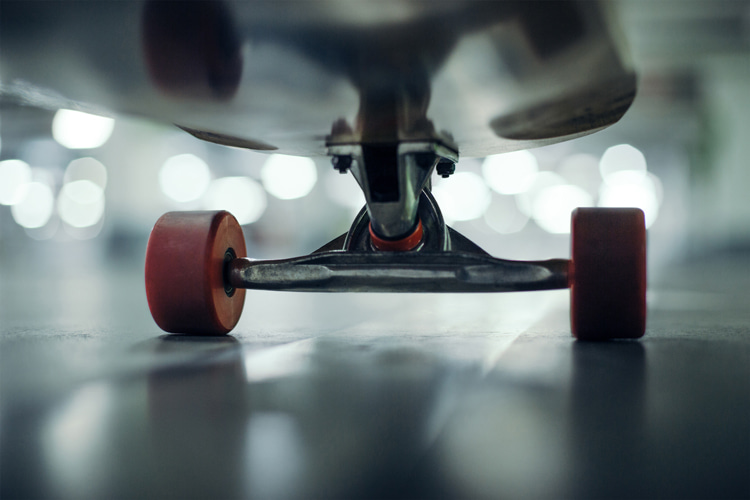Do you need to replace your old and used skateboard wheels? Have you bought a new set of bearings? Learn how to change them easily and quickly.
The more you skate, the less grip you’ll have on your wheels – they’ll start to get smaller and coned out.
The flat spots that can be found on the surface of the urethane wheel will not allow a smooth riding, resulting in uncomfortable vibrations and distracting noises.
So, when the time comes to change them, you’ve got to do it right.
The first thing you’ll need to do is to get the tools for the job, and any skateboard adjustment and assembly can be made with just one object.
The skate tool has different parts that fit with the various components of your board.
You’ll find a Phillips screwdriver for the baseplate bolts, two different sockets for your axle nuts and kingpin, and sometimes a few other features that make working on your skateboard easier.
Do have in mind that to get the most out of your wheels, you need to know where you’ll be using them and what you expect to do.
If you do most of your skateboarding at a classic concrete skatepark, a harder wheel will provide plenty of grip and speed.
Soft wheels in a smooth concrete skatepark might feel a little mushy.
If you are skating on asphalt parking lots and sidewalks, a softer wheel will help absorb the surface’s roughness to produce a smoother ride and more grip.
Hard wheels on a sidewalk will be loud and rough.
In the end, you will need eight bearings, four wheels, and eight spacer washers (optional).


Removing and Installing the Bearings
If you’re replacing your old bearings, you need to change them before moving on to the urethane wheels.
Inserting and removing bearings from the wheel can be a complicated experience, but there are a few tricks to make the whole process easy.
Let’s learn how to pop them off the wheels.
Grab a wheel and use the truck’s axle to pry off the bearing. Repeat the process on all eight bearings.
Some skate tools will have a small cylindrical protrusion for prying bearings out of wheels, but the end of the axle works well too.
Now, you’re ready for fresh wheels and bearings. It’s usually challenging to install them.
The best way is to use a bearing press – a special tool designed for inserting and removing bearings from wheels.
You can find a bearing press at any skate shop, but there are some tricks for doing it yourself.
Remember that two bearings go in each wheel, one on either side. They will slide directly into the space made for them, but it will be a tight fit.
You probably won’t be able to push them into place with just your fingers or thumbs.
Grab a wheel and one of the bearings, and try to push the bearing into the wheel.
If the bearing has one metal side and one plastic side – the dust guard – you should have the plastic side facing outward and the metal side on the inside when you insert it.
Some bearings have metal on both sides, so either way is acceptable. Keep the bearing even – you don’t want it inserted at an angle.
Now, slide the bearing and wheel over the axle of the trucks with the bearing closest to the hanger.
By applying even pressure to the wheel, the hanger will push the bearing into its seat. Don’t worry about not doing it right – you will know it when it’s nested.
You only need to get the bearing most of the way into the wheel.
Now remove the wheel, and insert a bearing into the other side using the same process.
When you have both the bearings in the wheel, you can slide the whole ensemble onto the axle. On most wheels, it doesn’t matter which side faces out.
However, if you like the printed graphics, you can always have that side facing out; if you prefer a simpler look, you can have the graphic side of the wheel facing inward.
Screwing the Nuts
It’s a good idea to put a washer as a spacer between the hanger and the inner bearing and another one between the outer bearing and the axle nut.
Do it by screwing the axle nut onto the axle as far as you can with your fingers, and then tighten it the rest of the way with your skate tool.
If you were not able to get the bearings completely seated, you can screw the nut down tight, and it should press the bearings fully into their place.
Although high-performance skaters and skate shops don’t recommend this method because it can be hard on the bearings, many riders do it without any noticeable issues.
When the nut is firmly tightened, back it off about half a rotation. The wheel should have just a little bit of jiggle along the axle, just enough that you easily feel and maybe even hear it.
Naturally, the wheel should spin freely. Repeat this process for the remaining six bearings and three wheels.
Last but not least, spin the wheels – they should spin easily, smoothly, and quietly. If a urethane wheel stops spinning quickly, loosen the nut a little until you can move the wheel a tiny bit along the axle.
If it still doesn’t spin smoothly, the bearings may be dirty or old.
Although you can soak the bearings in denatured alcohol and relube them, it’s generally easier to buy new ones.
The process of removing the old wheels and bearing and installing new ones shouldn’t take you more than 15 or 20 minutes.
Bibliography and References:
P. Welinder and P. Whitley. “Mastering Skateboarding.” Human Kinetics, 2012




Recent Comments